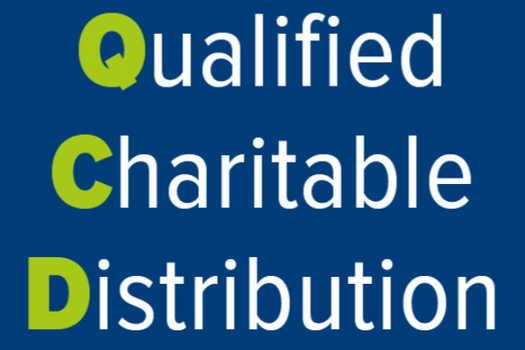Qualified Charitable Distribution QCD Guidelines

A Qualified Charitable Distribution is a tax-free withdrawal from an Individual Retirement Account (IRA) made directly to a qualifying charity.
It serves as a popular way to do good while also satisfying the IRA holder’s required minimum distribution (RMD). Available to owners and beneficiaries age 70½ or older, a QCD offers tax-free IRA distributions of up to $100,000 in 2023 ($105,000 in 2024).
Here, we discuss the importance of coordinating a RMD with a QCD to maximize tax benefits, Secure Act. 2.0 rule changes, and other rules you must be familiar with to ensure tax-free QCD treatment.
A Qualified Charitable Distribution is a tax-free withdrawal from an Individual Retirement Account (IRA) made directly to a qualifying charity. It serves as a popular way to do good while also satisfying the IRA holder’s required minimum distribution (RMD). Although not eligible for a charitable deduction, a QCD is not included in the IRA owner’s adjusted gross income (AGI) under IRS rules. Leveraging a QCD to lower one’s AGI could potentially reduce those taxes based on income, such as Social Security benefits or Medicare Parts B and D premium surcharges. Available to owners and beneficiaries age 70½ or older, a QCD offers tax-free IRA distributions of up to $100,000 in 2023 ($105,000 in 2024). Here, we discuss the importance of coordinating a RMD with a QCD to maximize tax benefits, Secure Act. 2.0 rule changes, and other rules you must be familiar with to ensure tax-free QCD treatment.
First-Dollars-Out Rule
RMDs start for IRA owners (excluding a Roth IRA) in the year they reach age 73. For IRA owners with charitable intentions, a potentially substantial tax benefit becomes available when a QCD is used. A QCD can reduce or even eliminate the income tax ordinarily due on RMD income. Notably, QCDs can start as early as 70½ (the account owner’s 70½ birthday), even though minimum distributions aren’t required until age 73.
To help ensure you receive QCD tax benefit, an individual must coordinate their QCD with their RMD, or the QCD may be treated as taxable income. Why? The first dollars withdrawn from an IRA in any year (an owner is subject to an RMD) are deemed to satisfy the RMD. This rule is referred to as the “first-dollars-out” rule, and that, in turn, creates a timing oddity for QCDs.
Caution: Coordinate the Timing to Properly Execute a QCD
Many IRA owners like to get their RMD out of the way by withdrawing from their IRA early in the year or taking systematic (i.e., monthly, quarterly, etc.) distributions. However, those individuals who want to reduce their RMD income should first make a QCD directly from the IRA to a qualifying charity, then take their annual RMD. We suggest doing QCDs early in the year to avoid any conflict with the first-dollars-out rule.
If an IRA owner is looking to offset the income from an RMD with a QCD, those transactions must be done in conjunction with each other. In other words, an IRA owner cannot take their RMD and then decide to retroactively do a QCD with those same dollars. Notably, a QCD can be done after an RMD is taken, but the QCD will be an additional distribution on top of the RMD.
TIP: QCDs for those individual’s age 73 or older are permitted from IRAs only (including an inherited IRA). QCDs cannot be done from an employer-sponsored retirement plan (i.e., 401(k), 403(b), 457(b), etc.).
Secure Act 2.0 enacted two new rules affecting QCDs. These changes are as follows:
- Maximum Annual QCD Amount Indexed for Inflation.QCD’s limit has remained at $100,000 (annually) since its inception in 2006. Beginning in 2024, the limit will now be linked to the rate of inflation. The 2024 QCD limit is $105,000.
- One-Time Opportunity to Fund a Split-Interest Entity.Beginning in 2023, account holders were offered a once-in-a-lifetime opportunity to use a QCD to fund a Charitable Remainder UniTrust (CRUT), Charitable Remainder Annuity Trust (CRAT), or Charitable Gift Annuity (CGA). The maximum (lifetime) distribution amount is $50,000 ($53,000 in 2024). This rule essentially allows a traditional IRA owner to move funds (to a split-interest entity) free of income or estate tax to future generations. However, it’s not that simple. There are several hurdles that must be satisfied before the individual can reap the tax benefits of such a transaction. We urge you to discuss this new opportunity with your financial and or tax professional.
Potential QCD Tax Traps
- To receive QCD treatment, a distribution of IRA funds must be done as a direct transfer to a qualifying charity. Donor-advised funds and private foundations do not qualify for QCD treatment.
- A QCD is a tax-free transfer from an IRA to a qualifying charity. However, a QCD is generally reported on IRS Form 1099-R “Distributions from Pensions, Annuities, Retirement or Profit-Sharing Plans, IRAs, Insurance Contracts, etc.” as a normal IRA distributionand thus included in taxable income. In other words, the 1099-R will not indicate the distribution is a QCD and therefore a non-taxable transaction. An IRA owner (or their beneficiary) must advise their tax professional to ensure the QCD tax benefit is received.
- The SECURE Act of 2019 removed the age limitation for contributing to a traditional IRA. Thus, an eligible individual with earned income, regardless of age, can now contribute to a traditional IRA. However, if you are 73 or older and make a deductible, traditional IRA contribution, any subsequent QCD (up to the amount of the deductible contribution) will be taxable.
- A QCD can only be done for the current calendar year; for example, a QCD for 2023 must be completed by December 31, 2023. If the deadline is missed, you can’t make a QCD for the prior tax year.
- A tax deduction cannot be taken for the charitable contribution, and nothing can be received in return for the donation.
- Itemization is not required to make a QCD.
- A QCD must consist of only pre-tax IRA funds. This raises the question: “How do I qualify for QCD treatment if any of my IRAs contain ‘basis ‘(after-tax dollars)?” QCDs are an exception to the IRS pro-rata distribution rule. QCDs are distributed from pre-tax funds first!
- Roth IRAs are generally not QCD-eligible because qualified Roth IRA distributions are tax-free. Thus, QCDs can be made from a Roth IRA onlyif the account owner had not satisfied the requirements for a “qualified distribution.”
A Qualified Charitable Distribution provides an excellent opportunity for retirement account owners to give something back from a lifetime of savings. We’re hopeful this information provides you with a good starting point to begin further exploration on the topic. As always, these are general guidelines and should not be construed as individualized tax advice. Always consult a tax professional to see if these ideas might apply to you specifically.
*This material was created to provide accurate and reliable information on the subjects covered but should not be regarded as a complete analysis of these subjects. It is not intended to provide specific legal, tax or other professional advice.
Foronjy Financial does not provide legal or tax advice. Please consult with your tax or legal advisor regarding your personal situation.

Would you like to have a meeting?
If you have questions about QCDs and would like to book a brief zoom session or phone call to explore how this strategy might apply to you, please click the link below to schedule a time for us to meet.
We're looking forward to meeting with you.

